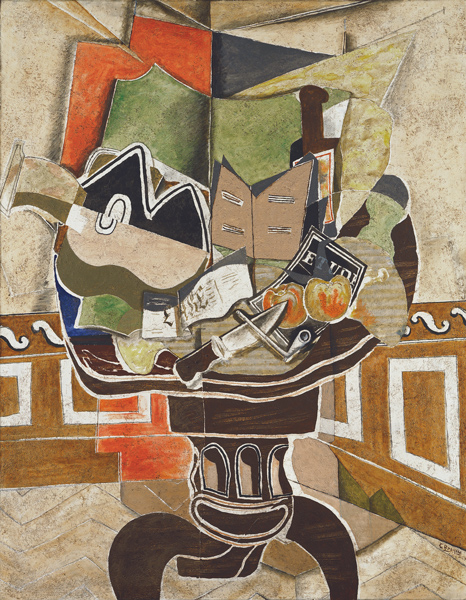
25 January-21 April 2013
“Georges Braque and the Cubist Still Life, 1928-1945”
Georges Braque (1882-1963) is one of the pioneers of collage. In 1912, he and Pablo Picasso experimented with collage and Braque came up with the technique known as a papier collé. But by the 1930s, as the rise of fascism brought new urgency to questions of aesthetics and politics — questions that entered mainstream consciousness with Picasso’s Guernica (1937) — Braque’s fractured still lifes and bourgeois interiors remained emphatically inward-looking.
Yet Braque’s painting was not as separate from outside events as Braque might have it. While his attention to the private, secluded realm of the still life suggests disengagement with historical and political circumstances, the paintings themselves convey a more complex narrative. Indeed, the artist’s exactingly internal gaze was precisely what made his work relevant to questions of art, engagement and responsibility.
The first major Braque show in the United States in 16 years, “Georges Braque and the Cubist Still Life, 1928-1945” features no works that are specifically collage, but the influence of collage is present in the work. Several works in the show include sand in the materials, such as The Napkin Ring (1929) and The Round Table (1929). And the fractured nature of the still lifes is reminiscent of collage.
For Braque’s supporters, his emphasis on creating unfamiliar worlds represented no less than a manifesto of human freedom and an attempt to break free from history and civilization. Carl Einstein, the German Jewish art historian who organized Braque’s first major retrospective — and who relocated to Paris in 1928 to edit the journal Documents with Georges Bataille — initially planned to title his 1934 monograph on Braque “La morale de la pureté (The morality of purity).”
But the war years proved difficult for the painter’s circle. In 1940, Rosenberg left Paris for New York as the Nazis seized his gallery, paintings and residence. Shortly thereafter, Einstein committed suicide in the French Pyrenees while fleeing the Gestapo, and Braque himself stopped painting for a time. Conversely, under the occupation government, other contemporaries judged Braque’s still lifes as sufficiently apolitical to be featured in a special exhibit as part of the 1943 Salon d’automne.
(adapted from the museum’s press materials)
INFORMATION
Mildred Lane Kemper Art Gallery
Washington University in St. Louis
Skinker & Forsythe Boulevards
St. Louis, Missouri 63112 USA
(314) 935-4523
Hours:
Monday, Wednesday, Thursday, Saturday, and Sunday, 11AM-6PM
Friday, 11AM-8PM
Closed Tuesday
Image:
The Round Table
by Georges Braque
57 3/8″x 44 3/4″
oil, sand, and charcoal on canvas
1929
Acquired 1934, The Phillips Collection, Washington, DC. © 2013 Artists Rights Society (ARS), New York / ADAGP, Paris.
